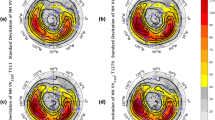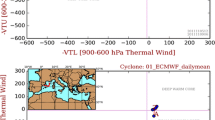Abstract
Model performance and future projection of Arctic summertime storm-track activity and associated background states are assessed on the basis of Coupled Model Intercomparison Project Phase 3 (CMIP3)/5 (CMIP5) climate models. Despite some improvement in the CMIP5 models relative to the CMIP3 models, most of the climate models underestimate summertime storm-track activity over the Arctic Ocean compared to six reanalysis data sets as measured locally as the variance of subweekly fluctuations of sea level pressure. Its large inter-model spread (i.e., model-to-model differences) is correlated with that of the intensity of the Beaufort Sea High and the lower-tropospheric westerlies in the Arctic region. Most of the CMIP3/5 models project the enhancement of storm-track activity over the Arctic Ocean off the eastern Siberian and Alaskan coasts, the region called the Arctic Ocean Cyclone Maximum, in association with the strengthening of the westerlies in the warmed climate. A model with stronger enhancement of the storm-track activity tends to accompany stronger land-sea contrast in surface air temperature across the Siberian coast, which reflects greater surface warming over the continent and slower warming over the Arctic Ocean. Other processes, however, may also be likely to contribute to the future changes of the storm-track activity, which gives uncertainty in the projection by multiple climate models. Our analysis suggests that further clarification of those processes that influence storm-track activity over the Arctic is necessary for more reliable future projections of the Arctic climate.












Similar content being viewed by others
Notes
A recent study found a maximum also in winter around the same domain based on the Arctic System Reanalysis (ASR) interim, which are not clear in global reanalysis data (Tilinina et al. 2014).
We only use CMIP5 models because some of data are not available for some of CMIP3 models.
References
Bengtsson L, Hodges KI, Roeckner E (2006) Storm tracks and climate change. J Clim 19:3518–3543
Brayshaw D, Hoskins BJ, Blackburn MJ (2008) The storm track response to idealized SST perturbations in an aquaplanet GCM. J Atmos Sci 65:2842–2860. doi:10.1175/2008JAS2657.1
Cattiaux J, Douville H, Peings Y (2013) European temperatures in CMIP5: origins of present-day biases and future uncertainties. Clim Dyn. doi:10.1007/s00382-013-1731-y
Chang EKM, Guo Y, Xia X (2012) CMIP5 multimodel ensemble projection of storm track change under global warming. J Geophys Res 117:D23118. doi:10.1029/2012JD018578
Chang EKM, Guo Y, Xia X, Zheng M (2013) Storm track activity in IPCC AR4/CMIP3 model simulations. J Clim 26:246–258. doi:10.1175/JCLID-11-00707.1
Dee DP et al (2011) The ERA-Interim reanalysis: configuration and performance of the data assimilation system. Q J R Meteorol Soc 137:553–597
Ebita A et al (2011) The Japanese 55-year reanalysis “JRA-55”: an interim report. SOLA 7:149–152
Harvey BJ, Shaffrey LC, Woollings TJ (2013) Equator-to-pole temperature differences and the extra-tropical storm track responses of the CMIP5 climate models. Clim Dyn. doi:10.1007/s00382-013-1883-9
Hoskins BJ, McIntyre ME, Robertson AW (1985) On the use and significance of isentropic potential vorticity maps. Q J R Met Soc 111:877–946
Inoue J, Enomoto T, Miyoshi T, Yamane S (2009) Impact of observations from Arctic drifting buoys on the reanalysis of surface fields. Geophys Res Lett 36:L08501. doi:10.1029/2009GL037380
Inoue J, Enomoto T, Hori ME (2013) The impact of radiosonde data over the ice-free Arctic Ocean on the atmospheric circulation in the Northern Hemisphere. Geophys Res Lett 40:864–869. doi:10.1002/grl.50207
Jungclaus JH, Koenigk T (2010) Low-frequency variability of the arctic climate: the role of oceanic and atmospheric heat transport variations. Clim Dyn 34:265–279. doi:10.1007/s00382-009-0569-9
Kalnay E et al (1996) The NCEP/NCAR 40-year reanalysis project. Bull Am Meteorol Soc 77(3):437–471
Lambert SJ, Fyfe JC (2006) Changes in winter cyclone frequencies and strengths simulated in enhanced greenhouse warming experiments: results from the models participating in the IPCC diagnostic exercise. Clim Dyn 26:713–728. doi:10.1007/s00382-006-0110-3
Lang C, Waugh DW (2011) Impact of climate change on the frequency of Northern Hemisphere summer cyclones. J Geophys Res 116:D041103. doi:10.1029/2010JD014300
Long Z, Perrie W (2012) Air-sea interactions during an Arctic storm. J Geophys Res 117:D15103. doi:10.1029/2011JD016985
Meehl GA, Covey C, Delworth T, Latif M, McAvaney B, Mitchell JFB, Stouffer RJ, Taylor KE (2007) The WCRP CMIP3 multi-model dataset: a new era in climate change research. Bull Am Meteorol Soc 88:1383–1394
Mizuta R (2012) Intensification of extratropical cyclones associated with the polar jet change in the CMIP5 global warming projections. Geophys Res Lett 39:L19707. doi:10.1029/2012GL053032
Nakamura H, Shimpo A (2004) Seasonal variations in the Southern Hemisphere storm tracks and jet streams as revealed in a reanalysis dataset. J. Climate 17:1828–1844
Nakamura H, Izumi T, Sampe T (2002) Interannual and decadal modulations recently observed in the Pacific storm track activity and East Asian winter monsoon. J Clim 15:1855–1874
O’Gorman PA (2010) Understanding the varied response of the extratropical storm tracks to climate change. Proc Natl Acad Sci USA 107:19176–19180
Ogawa F, Nakamura H, Nishii K, Miyasaka T, Kuwano-Yoshida A (2012) Dependence of the climatological axial latitudes of the tropospheric westerlies and storm tracks on the latitude of an extratropical oceanic front. Geophys Res Lett 39:L05804
Ogi M, Wallace JM (2007) Summer minimum Arctic sea ice extent and the associated summer atmospheric circulation. Geophys Res Lett 34:L12705. doi:10.1029/2007GL029897
Ogi M, Yamazaki K, Tachibana Y (2004) The summertime annular mode in the Northern Hemisphere and its linkage to the winter mode. J Geophys Res 109:D20114. doi:10.1029/2004JD004514
Onogi K, Tsutsui J, Koide H, Sakamoto M, Kobayashi S, Hatsushika H, Matsumoto T, Yamazaki N, Kamahori H, Takahashi K, Kadokura S, Wada K, Kato K, Oyama R, Ose T, Mannoji N, Taira R (2007) The JRA-25 reanalysis. J Meteorol Soc Japan 85:369–432
Orsolini YJ, Sorteberg A (2009) Projected changes in Eurasian and Arctic summer cyclones under global warming in the Bergen climate model. Atmos Ocean Sci Lett 2:62–67
Oshima K, Yamazaki K (2004) Seasonal variation of moisture transport in the polar regions and the relation with annular modes. Polar Meteorol Glaciol 18:30–53
Oshima K, Yamazaki K (2006) Difference in seasonal variation of net precipitation between the Arctic and Antarctic regions. Geophys Res Lett 33:L18501. doi:10.1029/2006GL027389
Rayner NA, Parker DE, Horton EB, Folland CK, Alexander LV, Rowell DP, Kent EC, Kaplan A (2003) Global analyses of sea surface temperature, sea ice, and night marine air temperature since the late nineteenth century. J Geophys Res 108(14):4407. doi:10.1029/2002JD002670
Saha S et al (2010) The NCEP climate forecast system. J Clim 19:3483–3517
Screen JA, Simmonds I (2010) The central role of diminishing sea ice in recent Arctic temperature amplification. Nature 464:1334–1337. doi:10.1038/nature09051
Screen JA, Simmonds I, Keay K (2011) Dramatic interannual changes of perennial Arctic sea ice linked to abnormal summer storm activity. J Geophys Res 116:D15105. doi:10.1029/2011JD015847
Seneviratne SI, Lüthi D, Litschi M, Schär C (2006) Land-atmosphere coupling and climate change in Europe. Nature 443:205–209. doi:10.1038/nature05095
Serreze MC, Barrett AP (2008) The summer cyclone maximum over the central Arctic Ocean. J Clim 21:1048–1065
Serreze MC, Barrett AP (2011) Characteristics of the Beaufort Sea high. J Clim 24:159–182
Serreze MC, Barry RG (1988) Synoptic activity in the Arctic basin, 1979–85. J Clim 1:1276–1295
Serreze MC, Lynch AH, Clark MP (2001) The Arctic frontal zone as seen in the NCEP–NCAR reanalysis. J Clim 14:1550–1567
Simmonds I, Keay K (2009) Extraordinary September Arctic sea ice reductions and their relationships with storm behavior over 1979–2008. Geophys Res Lett 36:L19715. doi:10.1029/2009GL039810
Simmonds I, Rudeva I (2012) The great Arctic cyclone of August. Geophys Res Lett 39:L23709. doi:10.1029/2012GL054259
Sorteberg A, Walsh J (2008) Seasonal cyclone variability at 70°N and its impact on moisture transport into Arctic. Tellus 60A:570–586
Sorteberg A, Kattosov V, Walsh JE, Pavlova T (2007) The Arctic surface energy budget as simulated with the IPCC AR4 AOGCMs. Clim Dyn 29:131–156. doi:10.1007/s00382-006-0222-9
Taylor KE, Stouffer RJ, Meehl GA (2012) An overview of CMIP5 and the experiment design. Bull Am Meteorol Soc 93:485–498
Tilinina N, Gulev SK, Bromwich DH (2014) New view of Arctic cyclone activity from the Arctic system reanalysis. Geophys Res Lett 41. doi:10.1002/2013GL058924
Ulbrich U, Pinto JG, Kupfer H, Leckebusch GC, Spangehl T, Reyers M (2008) Changing Northern Hemisphere storm tracks in an ensemble of IPCC climate change simulations. J Clim 21:1669–1679
Uppala SM et al (2005) The ERA-40 re-analysis. Q J R Meteorol Soc 131:2961–3012. doi:10.1256/qj.04.176
Woollings T, Gregory JM, Pinto JG, Reyers M, Brayshaw DJ (2012) Response of the North Atlantic storm track to climate change shaped by ocean–atmosphere coupling. Nat Geosci 5:313–317. doi:10.1038/ngeo1438
Yin JH (2005) A consistent poleward shift of the storm tracks in simulations of 21st century climate. Geophys Res Lett 32:L18701. doi:10.1029/2005GL023684
Zappa G, Shaffrey LC, Hodges KI (2013a) The ability of CMIP5 models to simulate North Atlantic extratropical cyclones. J Clim 26:5379–5396. doi:10.1175/JCLI-D-12-00501.1
Zappa G, Shaffrey LC, Hodges KI, Sansom PG, Stephenson DB (2013b) A multimodel assessment of future projections of North Atlantic and European extratropical cyclones in the CMIP5 climate models. J Clim 26:5846–5862. doi:10.1175/JCLID-12-00573.1
Zhang X, He J, Zhang J, Polyakov IV, Gerdes R, Inoue J, Wu P (2012) Enhanced poleward moisture transport and amplified northern high-latitude wetting trend. Nat Clim Change 3:47–51. doi:10.1038/nclimate1631
Acknowledgments
KN and HN are supported in part by the Japanese Ministry of Environment through the Environment Research and Technology Development Fund A-1201 and by Japanese Ministry of Education, Culture, Sports, Science and Technology (MEXT) through a Grant-in-Aid for Scientific Research in Innovative Areas 2205. KN is supported by MEXT also through the GRENE Arctic Climate Change Research Project. YO is supported by the Norwegian Research Council East Asian DecCen Project (193690). We acknowledge the World Climate Research Program’s Working Group on Coupled Modeling, which is responsible for CMIP, and we thank all contributing climate modeling groups. The U.S. Department of Energy’s Program for Climate Model Diagnosis and Intercomparison provided coordination and support for CMIP, and led the development of software infrastructure in partnership with the Global Organization for Earth System Science Portals. We also acknowledge the “Data Integration and Analysis System” Fund (DIAS) for National Key Technology and the Innovative Program of Climate Change Projection for the 21st Century (“Kakushin” program) from MEXT.
Author information
Authors and Affiliations
Corresponding author
Electronic supplementary material
Below is the link to the electronic supplementary material.
Appendix: Partial correlation and regression
Appendix: Partial correlation and regression
Consider three variables of X i , Y i , and Z i , and linear regression equations among them:
where a x , b x , a y , and b y are constant. Then residuals ε xi and ε yi are not correlated with Z i . Correlation between ε xi and ε yi is the partial correlation between X i and Y i without influence of Z i . Regression coefficient of ε yi onto ε xi is partial regression of Y i onto X i without influence of Z i .
Rights and permissions
About this article
Cite this article
Nishii, K., Nakamura, H. & Orsolini, Y.J. Arctic summer storm track in CMIP3/5 climate models. Clim Dyn 44, 1311–1327 (2015). https://doi.org/10.1007/s00382-014-2229-y
Received:
Accepted:
Published:
Issue Date:
DOI: https://doi.org/10.1007/s00382-014-2229-y




